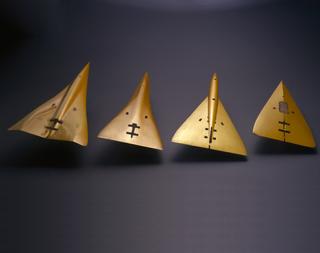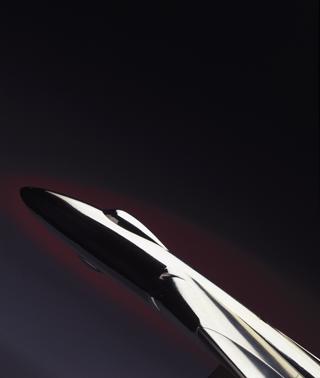
Kayak made of glass fibre reinforced plastic stiffened with carbon fibre
- Made:
- 1962-1980 in Shoreham-by-Sea
A KW7 Lowline kayak, made of glass fibre reinforced plastic stiffened with Grafil® Courtaulds Carbon fibres, manufactured by Streamlyte Mouldings (Marine) Ltd, c.1965-1979. The upper section is painted red, while the lower is left unpainted to show the structure. A plate on the body of the kayak reads: “KW Kayaks – nameplate by Malby-Cal Ltd, Brighton".
Glass fibre reinforced plastic, in this case stiffened with carbon fibres, is an example of a composite material. Composite materials consist of two or more substances combined together to make a material with different properties from the individual components. Fibre-reinforced composite materials can be made to be light, strong, easy to process, and can be moulded into complex shapes. These properties make them very popular and often preferred over the conventional, heavier alternatives of wood and steel.
The majority of all fibres used in the composites industry are glass. Glass fibre is the oldest and the most common reinforcement in most applications. It weighs more than the second most common reinforcement, carbon fibre, and, although is not as stiff, is more impact-resistant.
Between the 1950s and 1960s, the composites industry experienced significant growth and technological advancements, becoming very popular especially in sports, aerospace and automotive industries. In the late 1960s, motorsport started to use carbon fibre as reinforcing strands bonded to the large glass fibre body panels.
Fibreglass reinforced plastic started to be used in kayaking around the 1950s, allowing canoes to be built without a frame, creating an easier, more durable, and lighter construction. This example, built between the late 1960s and the late 1970s, shows the use of Grafil® Courtaulds Carbon fibre to stiffen fibreglass reinforced plastic.
Details
- Category:
- Farnborough
- Object Number:
- 1993-2648
- Materials:
- carbon fibre, resin (unidentified) and glass fibre
- Measurements:
-
overall (as displayed): hight = 4000 mm x width = 620 mm x depth = 350 mm,
- type:
- kayak




